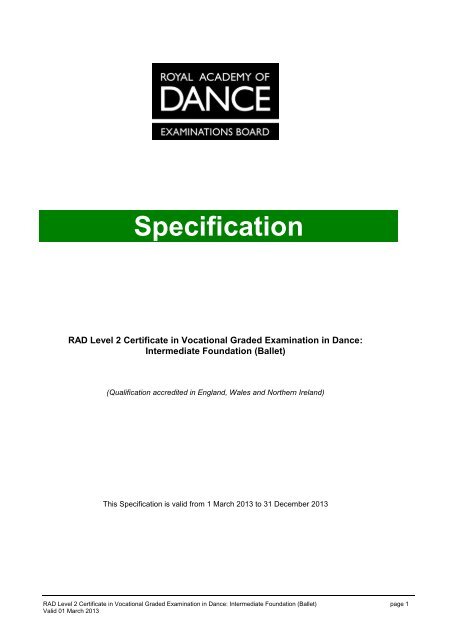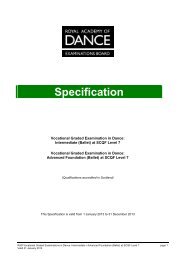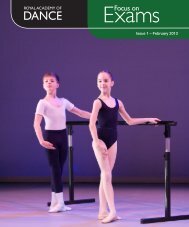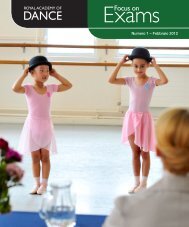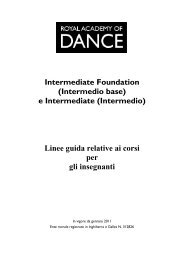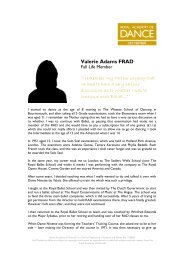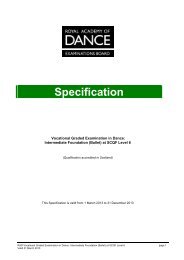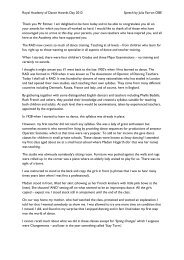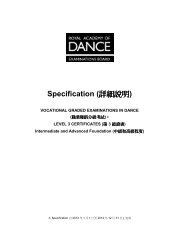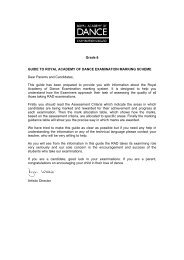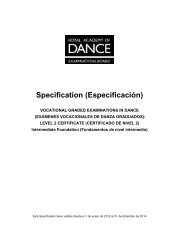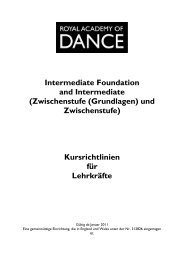QCF Intermediate Foundation Specification - Royal Academy of Dance
QCF Intermediate Foundation Specification - Royal Academy of Dance
QCF Intermediate Foundation Specification - Royal Academy of Dance
Create successful ePaper yourself
Turn your PDF publications into a flip-book with our unique Google optimized e-Paper software.
<strong>Specification</strong><br />
RAD Level 2 Certificate in Vocational Graded Examination in <strong>Dance</strong>:<br />
<strong>Intermediate</strong> <strong>Foundation</strong> (Ballet)<br />
(Qualification accredited in England, Wales and Northern Ireland)<br />
This <strong>Specification</strong> is valid from 1 March 2013 to 31 December 2013<br />
RAD Level 2 Certificate in Vocational Graded Examination in <strong>Dance</strong>: <strong>Intermediate</strong> <strong>Foundation</strong> (Ballet) page 1<br />
Valid 01 March 2013
The <strong>Royal</strong> <strong>Academy</strong> <strong>of</strong> <strong>Dance</strong> (RAD) is an international teacher education and awarding<br />
organisation for dance. It was established in 1920 as the Association <strong>of</strong> Operatic Dancing <strong>of</strong><br />
Great Britain, granted a <strong>Royal</strong> Charter in 1936 and renamed the <strong>Royal</strong> <strong>Academy</strong> <strong>of</strong> Dancing.<br />
In 1999 it became the <strong>Royal</strong> <strong>Academy</strong> <strong>of</strong> <strong>Dance</strong>.<br />
Vision:<br />
Leading the world in dance education and training, the <strong>Royal</strong> <strong>Academy</strong> <strong>of</strong> <strong>Dance</strong> will be<br />
recognised internationally for the highest standards <strong>of</strong> teaching and learning. As the<br />
pr<strong>of</strong>essional membership body for dance teachers it will inspire and empower dance<br />
teachers and students, members, and staff to make innovative, artistic and lasting<br />
contributions to dance and dance education throughout the world.<br />
Mission:<br />
To promote and enhance knowledge, understanding and practice <strong>of</strong> dance internationally by<br />
educating and training teachers and students and by providing examinations to reward<br />
achievement, so preserving the rich, artistic and educational value <strong>of</strong> dance for future<br />
generations.<br />
We will:<br />
Communicate openly<br />
Collaborate within and beyond the organisation<br />
Act with integrity and pr<strong>of</strong>essionalism<br />
Deliver quality and excellence<br />
Celebrate diversity and work inclusively<br />
Act as advocates for dance<br />
Examinations Department<br />
<strong>Royal</strong> <strong>Academy</strong> <strong>of</strong> <strong>Dance</strong><br />
36 Battersea Square<br />
London SW11 3RA<br />
+44 (0)20 7326 8000<br />
exams@rad.org.uk<br />
www.rad.org.uk/examinations<br />
© <strong>Royal</strong> <strong>Academy</strong> <strong>of</strong> <strong>Dance</strong> 2013<br />
ROYAL ACADEMY OF DANCE, RAD, RAD PRE-PRIMARY IN DANCE and RAD PRIMARY IN DANCE are<br />
registered trademarks® <strong>of</strong> the <strong>Royal</strong> <strong>Academy</strong> <strong>of</strong> <strong>Dance</strong>. RAD INTERMEDIATE FOUNDATION, RAD<br />
INTERMEDIATE, RAD CLASS AWARD, RAD SOLO PERFORMANCE AWARD and CBTS are unregistered<br />
trademarks <strong>of</strong> the <strong>Royal</strong> <strong>Academy</strong> <strong>of</strong> <strong>Dance</strong>. The use or misuse <strong>of</strong> the trademarks or any other content <strong>of</strong> this<br />
publication, without prior written permission from the <strong>Royal</strong> <strong>Academy</strong> <strong>of</strong> <strong>Dance</strong>, is strictly prohibited.<br />
The <strong>Royal</strong> <strong>Academy</strong> <strong>of</strong> <strong>Dance</strong> is incorporated in England as a <strong>Royal</strong> Charter corporation. It is registered as a<br />
Charity in England and Wales No. 312826.<br />
RAD Level 2 Certificate in Vocational Graded Examination in <strong>Dance</strong>: <strong>Intermediate</strong> <strong>Foundation</strong> (Ballet) page 2<br />
Valid 01 March 2013
Contents<br />
1 Objectives, aims and philosophy ............................................. 4<br />
2 Learning outcomes and assessment criteria ........................... 7<br />
3 Syllabus content ....................................................................... 9<br />
4 How marks are awarded .......................................................... 14<br />
5 Awarding and reporting ............................................................ 18<br />
6 Resources ................................................................................ 19<br />
This <strong>Specification</strong> should be read in conjunction with the document:<br />
Examinations Information, Rules and Regulations<br />
available on request from the RAD Examinations Department<br />
and on the RAD website: www.rad.org.uk<br />
RAD Level 2 Certificate in Vocational Graded Examination in <strong>Dance</strong>: <strong>Intermediate</strong> <strong>Foundation</strong> (Ballet) page 3<br />
Valid 01 March 2013
1 Objectives, aims, and philosophy<br />
1.1 Summary<br />
1.1.1 <strong>Intermediate</strong> <strong>Foundation</strong> constitutes Level 2 <strong>of</strong> the RAD’s Vocational Graded syllabus<br />
provision in the performance <strong>of</strong> ballet. It is the first in a suite <strong>of</strong> five levels from<br />
<strong>Intermediate</strong> <strong>Foundation</strong> to Advanced 2. An entry pathway to <strong>Intermediate</strong><br />
<strong>Foundation</strong> is provided by the RAD’s Graded syllabus.<br />
1.1.2 <strong>Intermediate</strong> <strong>Foundation</strong> is <strong>of</strong>fered as an Examination.<br />
1.2 Objectives<br />
1.2.1 The knowledge and skills gained through successful completion <strong>of</strong> this qualification<br />
provide a basis for progression to subsequent RAD Vocational Graded levels, as well<br />
as Vocational Graded Examinations in a range <strong>of</strong> dance genres <strong>of</strong>fered by other<br />
Awarding Organisations.<br />
1.2.2 Graded and Vocational Graded Examinations in <strong>Dance</strong> provide the basis <strong>of</strong> courses<br />
<strong>of</strong> study which lead to recognised achievement at a high level in dance performance.<br />
The higher levels <strong>of</strong> these qualifications are accepted as benchmarks <strong>of</strong> achievement<br />
by Vocational Schools which are attended by the majority <strong>of</strong> young dancers intending<br />
to enter the pr<strong>of</strong>ession. They are also taken into account by universities and other<br />
HE institutions <strong>of</strong>fering degree courses and programmes in dance and dance teacher<br />
education (such as the RAD itself). Such qualifications also facilitate or aid<br />
progression to workplace opportunities such as: pr<strong>of</strong>essional dancer, pr<strong>of</strong>essional<br />
dance teacher, pr<strong>of</strong>essional choreographer, pr<strong>of</strong>essional dance notator, pr<strong>of</strong>essional<br />
dance historian, lecturer in dance, and facilitator in community dance.<br />
1.2.3 Achievement in dance contributes to a learner’s all-round achievement, as it helps to<br />
develop competencies such as motor control, health and safety awareness,<br />
self-expression, physical fitness and stamina, discipline, mental ability and<br />
confidence.<br />
1.3 Aims<br />
1.3.1 The aims <strong>of</strong> the Vocational Graded Syllabus qualifications are to:<br />
provide a means <strong>of</strong> measuring the acquisition <strong>of</strong> technical, musical and<br />
performance skills in ballet<br />
provide candidates with a sound ballet base in preparation for further training<br />
and/or a career in dance or dance related subjects<br />
provide a progressive measure <strong>of</strong> attainment in ballet against specific criteria<br />
provide candidates with a series <strong>of</strong> clearly defined goals, which reflect the<br />
principles <strong>of</strong> safe dance practice<br />
provide candidates with an opportunity to gain internationally recognised<br />
qualifications in ballet to an advanced level.<br />
1.3.2 A course <strong>of</strong> study based on these qualifications aims to provide students with an<br />
increasing ability to demonstrate in-depth knowledge and practical skills in ballet.<br />
RAD Level 2 Certificate in Vocational Graded Examination in <strong>Dance</strong>: <strong>Intermediate</strong> <strong>Foundation</strong> (Ballet) page 4<br />
Valid 01 March 2013
1.4 Philosophy<br />
1.4.1 The underlying philosophy <strong>of</strong> this level expands upon embodied knowledge and<br />
understanding <strong>of</strong> ballet technique nurtured in the Graded syllabus. The syllabus<br />
challenges and inspires students technically, artistically, musically and creatively with<br />
exercises that encourage critical thinking and physical fitness while also developing a<br />
sense <strong>of</strong> theatre, movement dynamics and musical interpretation.<br />
1.5 Fitness for purpose<br />
1.5.1 A qualification will only be fit for purpose if that qualification, as far as possible,<br />
secures the requirements <strong>of</strong><br />
validity<br />
reliability<br />
comparability<br />
manageability<br />
minimising bias<br />
1.5.2 The RAD aims to secure these requirements by the following means:<br />
appointing Examiners who are subject experts, and who demonstrate their<br />
suitability for the role <strong>of</strong> assessor via the outcomes <strong>of</strong> a rigorous and extensive<br />
training programme<br />
monitoring the work <strong>of</strong> Examiners by holding annual training seminars,<br />
organising periodic moderation exercises, organising standardisation visits, and<br />
producing an Annual Review for each Examiner<br />
carrying out reviews <strong>of</strong> syllabus content and marking methodologies which lead<br />
the way in defining best practice in dance assessment<br />
carrying out quality assurance checks on results, including statistical analysis <strong>of</strong><br />
marks and adjustment where appropriate<br />
having policies and procedures related to diversity and equality which seek to<br />
maximise access to examination, identify and mitigate barriers, and ensure that<br />
all candidates are assessed in the same way regardless <strong>of</strong> their personal<br />
characteristics<br />
setting out clearly how Reasonable Adjustments and Special Consideration<br />
may be applied in relation to examinations<br />
identifying conflicts <strong>of</strong> interest and setting out how these are managed.<br />
The full policies and procedures related to the above matters are available on<br />
request.<br />
1.6 Required knowledge, skills and understanding<br />
1.6.1 No previous attainment in dance is necessary in order to enter for this Examination.<br />
1.6.2 An indication <strong>of</strong> required knowledge, skills and understanding is provided by the<br />
RAD’s Level 2 Awards in Graded Examination in <strong>Dance</strong>: Grades 4/5 (Ballet). Please<br />
consult the relevant <strong>Specification</strong> for more information.<br />
RAD Level 2 Certificate in Vocational Graded Examination in <strong>Dance</strong>: <strong>Intermediate</strong> <strong>Foundation</strong> (Ballet) page 5<br />
Valid 01 March 2013
1.7 Further information<br />
1.7.1 Further information about policies and procedures related to RAD Examinations,<br />
rules and regulations, and information about recognition and accreditation, may be<br />
found in the document Examinations Information, Rules and Regulations, available<br />
on request from the RAD Examinations Department and on the RAD website<br />
(www.rad.org.uk).<br />
RAD Level 2 Certificate in Vocational Graded Examination in <strong>Dance</strong>: <strong>Intermediate</strong> <strong>Foundation</strong> (Ballet) page 6<br />
Valid 01 March 2013
2 Learning outcomes and assessment<br />
criteria<br />
2.1 The learning outcomes and assessment criteria set out in 2.2 below are taken from<br />
the units against which the qualifications are mapped on the Qualifications and Credit<br />
Framework (<strong>QCF</strong>) in England, Wales and Northern Ireland. For more information,<br />
see Examinations Information, Rules and Regulations, Section 2.<br />
Learning outcomes describe what a learner should know, understand or be able to do<br />
on completion <strong>of</strong> a learning process, defined in terms <strong>of</strong> knowledge, skills and<br />
competence.<br />
Assessment criteria specify the standard a learner is expected to meet in order to<br />
demonstrate that the learning outcomes have been achieved.<br />
2.2 Learning outcomes<br />
The learner will:<br />
apply and demonstrate through<br />
performance a range <strong>of</strong><br />
fundamental and relevant<br />
knowledge and understanding <strong>of</strong><br />
the vocabulary and technique <strong>of</strong><br />
ballet<br />
perform a range <strong>of</strong> movement<br />
sequences showing sound and<br />
secure technical skills in ballet<br />
perform a range <strong>of</strong> movement<br />
sequences showing an<br />
understanding <strong>of</strong> musicality in ballet<br />
apply and demonstrate a range <strong>of</strong><br />
performance skills in ballet<br />
Assessment criteria<br />
The learner can:<br />
apply and demonstrate a sound knowledge and<br />
understanding <strong>of</strong> the mechanics and purpose <strong>of</strong><br />
the required vocabulary<br />
respond to and interpret direction correctly<br />
demonstrate strength and stamina in technical<br />
skills<br />
demonstrate a disciplined approach in a range<br />
<strong>of</strong> technical skills including: spatial awareness,<br />
control, co-ordination<br />
demonstrate a clear understanding <strong>of</strong> a more<br />
complex range <strong>of</strong> rhythmical sounds, accents<br />
and timings<br />
demonstrate a clear understanding <strong>of</strong> musical<br />
interpretation within more complex sequences<br />
including: phrasing, dynamics, atmosphere<br />
demonstrate the ability to engage an audience<br />
demonstrate an emerging awareness <strong>of</strong> the<br />
subtleties <strong>of</strong> performance including: expression,<br />
communication, projection<br />
2.3 A candidate who has successfully completed a course <strong>of</strong> study based on<br />
<strong>Intermediate</strong> <strong>Foundation</strong> will be able to:<br />
Technique<br />
demonstrate knowledge and understanding <strong>of</strong> the fundamental and relevant<br />
technique required at Level 2<br />
demonstrate co-ordination, control and accuracy in a range <strong>of</strong> sequences<br />
perform with an awareness <strong>of</strong> line<br />
perform with spatial awareness <strong>of</strong> the body in travelling movements and turning<br />
actions<br />
RAD Level 2 Certificate in Vocational Graded Examination in <strong>Dance</strong>: <strong>Intermediate</strong> <strong>Foundation</strong> (Ballet) page 7<br />
Valid 01 March 2013
Music<br />
demonstrate an awareness <strong>of</strong> the appropriate dynamic values in the<br />
performance <strong>of</strong> the vocabulary<br />
perform a range <strong>of</strong> movements en pointe with control (female only).<br />
demonstrate understanding <strong>of</strong> a range <strong>of</strong> movements within different rhythmical<br />
frameworks<br />
perform with an awareness <strong>of</strong> phrasing and appropriate use <strong>of</strong> musical<br />
dynamics.<br />
Performance<br />
perform showing understanding <strong>of</strong> interpretation and expression<br />
demonstrate communication and projection in performance.<br />
2.4 In this Level 2 qualification, candidates are expected to demonstrate knowledge <strong>of</strong><br />
vocabulary as defined by the syllabus content. An understanding <strong>of</strong> technique is<br />
reflected in the ability to co-ordinate movements to produce combinations <strong>of</strong> steps<br />
with appropriate quality <strong>of</strong> movement, within the range <strong>of</strong> the candidates’ physical<br />
capacity.<br />
2.5 Candidates demonstrate that they can confidently communicate to an audience.<br />
They are able to interpret music and display sensitivity to the musical content and<br />
style <strong>of</strong> the movements.<br />
RAD Level 2 Certificate in Vocational Graded Examination in <strong>Dance</strong>: <strong>Intermediate</strong> <strong>Foundation</strong> (Ballet) page 8<br />
Valid 01 March 2013
3 Syllabus content<br />
3.1 General<br />
3.1.1 Candidates will be examined through the performance <strong>of</strong> the set exercises and their<br />
choice <strong>of</strong> variation as detailed in the Set exercises and variations book (see 3.1.5<br />
below).<br />
3.1.2 Candidates are normally seen in groups <strong>of</strong> four; however candidates entered at RAD<br />
Approved Venues should be prepared to dance in any combination <strong>of</strong> groups, from<br />
solo up to a maximum <strong>of</strong> four, as scheduled. Candidates entering at Approved<br />
Examination Centres will be prepared in groups <strong>of</strong> between 1 and 4 by their teacher<br />
according to the published guidelines.<br />
3.1.3 Each examination set may contain any combination <strong>of</strong> male and female candidates.<br />
3.1.4 The Examiner will advise which candidates and in what order they perform when<br />
dancing in pairs or solo. In the shaded areas <strong>of</strong> the table in 3.3 below, the order <strong>of</strong><br />
the exercises will be dependent on the composition <strong>of</strong> male and female candidates in<br />
the set.<br />
3.1.5 Detailed descriptions <strong>of</strong> the set exercises and variations required for the examination<br />
are published in the Set exercises and variations book, formerly known as the<br />
Syllabus (see Section 6 below - Resources) which may be purchased from RAD<br />
Enterprises Ltd, through mail order, personal shopping or from its website:<br />
www.radenterprises.co.uk<br />
3.1.6 For more information about preparation, requirements and procedure, see<br />
Examinations Information, Rules and Regulations, Sections 4 and 5.<br />
3.2 Vocabulary<br />
Candidates are expected to have knowledge <strong>of</strong> the following vocabulary:<br />
Arabesques<br />
1st arabesque<br />
2nd arabesque<br />
Female Male<br />
Assemblés<br />
Assemblé devant, derrière, dessus and<br />
dessous<br />
Parallel assemblé en avant and en tournant<br />
Petit assemblé devant and derrière<br />
Balancés<br />
Balancé de côté<br />
Battements fondus<br />
Battement fondu à terre devant, to 2nd and<br />
derrière<br />
Battements frappés<br />
Battement frappé to 2nd<br />
Arabesques<br />
1st arabesque<br />
2nd arabesque<br />
Assemblés<br />
Assemblé devant, derrière, dessus and<br />
dessous<br />
Petit assemblé devant and derrière<br />
Balancés<br />
Balancé de côté<br />
Battements fondus<br />
Battement fondu à terre devant, to 2nd and<br />
derrière<br />
Battements frappés<br />
Battement frappé to 2nd<br />
RAD Level 2 Certificate in Vocational Graded Examination in <strong>Dance</strong>: <strong>Intermediate</strong> <strong>Foundation</strong> (Ballet) page 9<br />
Valid 01 March 2013
Female Male<br />
Battements glissés<br />
Battement glissé devant, to 2nd and derrière<br />
from 5th position in 2 counts<br />
Battement glissé to 2nd from 1st position in<br />
1 count<br />
Battements tendus<br />
Battement tendu devant, to 2nd and derrière<br />
from 5th position in 2 counts<br />
Changements<br />
Changement by ¼ turn<br />
Changement battu<br />
Chassés<br />
Chassé en avant and en arrière<br />
Chassé to 2nd position<br />
Chassé passé en avant<br />
Battements glissés<br />
Battement glissé devant, to 2nd and derrière<br />
from 5th position in 2 counts<br />
Battement glissé to 2nd from 1st position in<br />
1 count<br />
Battements tendus<br />
Battement tendu devant, to 2nd and derrière<br />
from 5th position in 2 counts<br />
Cabrioles<br />
Cabriole de côté in parallel 1st position<br />
Changements<br />
Changement by ¼ turn<br />
Grand changement<br />
Changement battu<br />
Chassés<br />
Chassé en avant and en arrière<br />
Chassé to 2nd position<br />
Chassé passé en avant<br />
Classical walks Classical walks<br />
Coupés<br />
Coupé dessus and dessous<br />
Courus<br />
Courus en tournant, en demi-pointe and en<br />
demi plié<br />
Courus sur place en pointe<br />
Développés<br />
Développé devant and to 2nd position<br />
Echappés relevés<br />
Echappé relevé changé en demi-pointe<br />
Echappé relevé changé en pointe<br />
Echappés sautés<br />
Echappé sauté battu fermé<br />
Echappé sauté fermé from 2nd position<br />
Echappé sauté changé<br />
Echappé sauté to 2nd position<br />
Glissades<br />
Glissade devant, derrière, dessus and<br />
dessous<br />
Running glissade en avant and de côté<br />
Grands battements<br />
Grand battement devant, to 2nd and derrière<br />
Grand battement en cloche<br />
Jetés<br />
Grand jeté en avant<br />
Jeté in petit attitude devant<br />
Jeté ordinaire devant and derrière<br />
Jeté passé devant and derrière<br />
Coupés<br />
Coupé dessus and dessous<br />
Développés<br />
Développé devant and to 2nd position<br />
Echappés relevés<br />
Echappé relevé changé en demi-pointe<br />
Echappés sautés<br />
Echappé sauté battu fermé<br />
Echappé sauté fermé from 2nd position<br />
Echappé sauté changé<br />
Echappé sauté to 2nd position<br />
Glissades<br />
Glissade devant, derrière, dessus and<br />
dessous<br />
Running glissade en avant and de côté<br />
Grands battements<br />
Grand battement devant, to 2nd and derrière<br />
Grand battement en cloche<br />
Jetés<br />
Grand jeté en avant<br />
Jeté en avant at glissé height<br />
Jeté ordinaire devant and derrière<br />
RAD Level 2 Certificate in Vocational Graded Examination in <strong>Dance</strong>: <strong>Intermediate</strong> <strong>Foundation</strong> (Ballet) page 10<br />
Valid 01 March 2013
Female Male<br />
Pas de bourrées<br />
Pas de bourrées devant, derrière, dessus<br />
and dessous<br />
Pas de chats Pas de chats<br />
Pas de valses<br />
Pas de valse en tournant<br />
Pas soutenus<br />
Pas soutenu devant and derrière<br />
Pas de bourrées<br />
Pas de bourrées devant, derrière, dessus<br />
and dessous<br />
Pas soutenus<br />
Pas soutenu devant and derrière<br />
Petits battements Petits battements<br />
Pirouettes<br />
En dehors: single from demi-plié in 4th<br />
position<br />
En dedans: single from 4th position en fondu<br />
Pivots<br />
Pivots à terre<br />
Pivot steps<br />
Pivot step de côté en face<br />
Pivot step en tournant<br />
Pliés<br />
Demi-plié in 1st, 2nd, 4th and 5th positions<br />
Grand plié in 1st, 2nd and 5th positions<br />
Port de bras<br />
Port de bras with forward bend<br />
Port de bras with side bend<br />
Port de bras with back bend<br />
Posés<br />
Posé en avant, en arrière and de côté<br />
Posé en avant into 1st arabesque en<br />
demi-pointe<br />
Posé into retiré and retiré derrière en<br />
demi-pointe<br />
Poses <strong>of</strong> the body<br />
Croisé devant<br />
Croisé derrière<br />
Effacé devant<br />
Effacé derrière<br />
Relevés<br />
Relevé in 1st, 2nd and 5th position<br />
Relevé devant and derrière<br />
Relevé passé devant and derrière<br />
Rises<br />
Rise onto demi-pointe in 1st, 2nd and 5th<br />
position<br />
Rise onto pointe in 1st position<br />
Pirouettes<br />
En dehors: single from demi-plié in 4th<br />
position<br />
En dedans: single from 4th position en fondu<br />
Single from 4th position en fondu in parallel<br />
retiré<br />
Pivots<br />
Pivots à terre<br />
Pliés<br />
Demi-plié in 1st, 2nd, 4th and 5th positions<br />
Grand plié in 1st, 2nd and 5th positions<br />
Grand plié in parallel 1st position<br />
Port de bras<br />
Port de bras with forward bend<br />
Port de bras with side bend<br />
Port de bras with back bend<br />
Posés<br />
Posé en avant, en arrière and de côté<br />
Posé into retiré derrière en demi-pointe<br />
Poses <strong>of</strong> the body<br />
Croisé devant<br />
Croisé derrière<br />
Effacé devant<br />
Effacé derrière<br />
Relevés<br />
Relevé in 1st, 2nd and 5th position<br />
Relevé devant and derrière<br />
Relevé passé devant and derrière<br />
Rises<br />
Rise onto demi-pointe in 1st, 2nd and 5th<br />
position<br />
RAD Level 2 Certificate in Vocational Graded Examination in <strong>Dance</strong>: <strong>Intermediate</strong> <strong>Foundation</strong> (Ballet) page 11<br />
Valid 01 March 2013
Female Male<br />
Ronds de jambe<br />
Demi grand rond de jambe en dehors and<br />
en dedans<br />
Demi rond de jambe en dehors and en<br />
dedans à terre<br />
Ronds de jambe (cont.)<br />
Rond de jambe à terre, en dehors and en<br />
dedans<br />
Sautés<br />
Sauté in 1st, 2nd and 4th position<br />
Sissonnes<br />
Sissonne fermée de côté devant, derrière,<br />
dessus and dessous<br />
Soubresauts Soubresauts<br />
Spring points Spring points<br />
Temps levés<br />
Temps levé in attitude devant<br />
Temps levé with low développé passé<br />
devant<br />
Temps levé in parallel retiré<br />
Temps levé in retiré derrière<br />
Temps levé in 1st and 2nd arabesque<br />
Temps liés<br />
Basic temps lié en avant<br />
Basic temps lié to 2nd<br />
Transfers <strong>of</strong> weight<br />
Basic transfer <strong>of</strong> weight in 2nd position<br />
Full transfer <strong>of</strong> weight through 2nd position<br />
Full transfer <strong>of</strong> weight through 4th position<br />
en avant and en arrière<br />
Ronds de jambe<br />
Demi grand rond de jambe en dehors and<br />
en dedans<br />
Demi rond de jambe en dehors and en<br />
dedans à terre<br />
Ronds de jambe (cont.)<br />
Rond de jambe à terre, en dehors and en<br />
dedans<br />
Sautés<br />
Sauté in 1st, 2nd and 4th position<br />
Sauté in parallel 1st position<br />
Sissonnes<br />
Sissonne fermée de côté devant, derrière,<br />
dessus and dessous<br />
Temps levés<br />
Temps levé in attitude devant<br />
Temps levé in parallel retiré<br />
Temps levé in 1st and 2nd arabesque<br />
Temps liés<br />
Basic temps lié en avant<br />
Basic temps lié to 2nd<br />
Tours en l'air<br />
Single tour en l'air<br />
Free enchaînement vocabulary<br />
Transfers <strong>of</strong> weight<br />
Basic transfer <strong>of</strong> weight in 2nd position<br />
Full transfer <strong>of</strong> weight through 2nd position<br />
Full transfer <strong>of</strong> weight through 4th position<br />
en avant and en arrière<br />
Focal Step: Sissonnes fermées de côté, devant, derrière, dessus and dessous<br />
Linking Steps: Pas de bourrées devant, derrière, dessus and dessous<br />
Changement, changement battu, relevé in 5th position<br />
Focal Step: Assemblés devant, derrière, dessus and dessous<br />
Linking Steps: Glissades devant, derrière, dessus and dessous<br />
Changement, changement battu, relevé in 5th position<br />
Focal Step: Jetés ordinaires devant and derrière<br />
Linking Steps: Petits assemblés devant and derrière<br />
Temps levé (not in a series)<br />
Changement, changement battu, relevé in 5th position<br />
RAD Level 2 Certificate in Vocational Graded Examination in <strong>Dance</strong>: <strong>Intermediate</strong> <strong>Foundation</strong> (Ballet) page 12<br />
Valid 01 March 2013
3.3 Examination Content (format)<br />
Candidates should prepare all the content listed, a selection <strong>of</strong> which will be seen in<br />
the examination:<br />
BARRE<br />
Content Format with four candidates<br />
Pliés<br />
Battements tendus<br />
Battements glissés<br />
Ronds de jambe à terre<br />
Battements fondus<br />
Battements frappés and petits battements<br />
Adage<br />
Grands battements and grands battements<br />
en cloche<br />
CENTRE<br />
Port de bras<br />
Centre practice and pirouettes en dehors<br />
Female: Pirouettes en dedans and posé<br />
pirouettes<br />
Male: Pirouettes en dedans and posé<br />
pirouettes<br />
Adage<br />
Allegro 1<br />
Allegro 2<br />
Free enchaînement*<br />
Allegro 3<br />
Female: Variation 1 or 2<br />
Male: Variation 1 or 2<br />
Male : Allegro 4<br />
Male : Allegro 5<br />
POINTE BARRE (female candidates only)<br />
Rises<br />
Echappés relevés and courus<br />
POINTE CENTRE (female candidates only)<br />
All together (all exercises)<br />
All together<br />
In pairs<br />
Solo<br />
RAD Level 2 Certificate in Vocational Graded Examination in <strong>Dance</strong>: <strong>Intermediate</strong> <strong>Foundation</strong> (Ballet) page 13<br />
Valid 01 March 2013<br />
Solo<br />
In pairs<br />
All together<br />
In pairs<br />
In pairs<br />
Solo<br />
Solo<br />
Solo<br />
In pairs<br />
In pairs<br />
Echappés relevés and classical walks All together<br />
RÉVÉRENCE Solo<br />
All together (both exercises)<br />
* Candidates will be asked to perform one free enchaînement, set by the Examiner and<br />
performed between Allegro 2 and Allegro 3. The enchaînement will take the form <strong>of</strong> a series <strong>of</strong><br />
one focal step with use <strong>of</strong> linking steps, as indicated in the vocabulary above.
4 How marks are awarded<br />
4.1 Overview <strong>of</strong> the markscheme<br />
4.1.1 The learning outcomes and assessment criteria detailed in Section 2 above are<br />
differentiated across the examination via three interrelated domains <strong>of</strong> assessment -<br />
Technique, Music and Performance.<br />
4.1.2 These domains <strong>of</strong> assessment are assessed via a markscheme which comprises ten<br />
component marks, which are applied as appropriate to the various requirements <strong>of</strong><br />
the examination. Some are applied to one particular section <strong>of</strong> the exam (e.g.<br />
‘Barre’) while others are generic to more than one section, as indicated in the tables<br />
below.<br />
4.1.3 The component marks are defined by the assessment <strong>of</strong> a number <strong>of</strong> interrelated<br />
technical elements which contribute to the skill and ability <strong>of</strong> the dancer,<br />
i.e. co-ordination, control, line, spatial awareness, dynamic values and the specific<br />
studies <strong>of</strong> Pointe work for Females and Allegro for Males. All these elements require<br />
a sound classical technique incorporating correct posture, weight placement and use<br />
<strong>of</strong> turnout. Definitions <strong>of</strong> the terms used are given in Section 4.3 below.<br />
4.1.4 In the examination, the Examiner awards a mark <strong>of</strong> between 0 and 10 for each<br />
component mark. A mark <strong>of</strong> 1 or higher signifies the standard attained by the<br />
candidate with respect to that component. A mark <strong>of</strong> 0 signifies that no work was<br />
shown for the section <strong>of</strong> the exam relating to that component. The table in section<br />
4.4 below explains the standard which the candidate needs to demonstrate, in<br />
relation to the elements contained within each component, in order to achieve these<br />
marks.<br />
4.1.5 In the examination, candidates will be assessed on their ability to:<br />
perform a series <strong>of</strong> prepared ballet exercises which require the ability to<br />
demonstrate secure posture, correct weight placement, co-ordination <strong>of</strong> the whole<br />
body, control, line, spatial awareness, dynamic values, and (for female<br />
candidates), the ability to successfully perform movements en pointe<br />
dance, throughout the examination, in time to the music and show responsiveness<br />
to the music<br />
dance, throughout the examination, with expression, interpretation, communication<br />
and projection<br />
perform one unprepared enchaînement in accordance with the Examiner’s<br />
instructions, demonstrating a secure knowledge <strong>of</strong> the required vocabulary and all<br />
the above aspects <strong>of</strong> Technique, Music and Performance<br />
perform one Variation which requires all the above aspects <strong>of</strong> Technique, Music<br />
and Performance.<br />
RAD Level 2 Certificate in Vocational Graded Examination in <strong>Dance</strong>: <strong>Intermediate</strong> <strong>Foundation</strong> (Ballet) page 14<br />
Valid 01 March 2013
4.2 <strong>Intermediate</strong> <strong>Foundation</strong>: Markscheme<br />
Examination content Component<br />
marks<br />
EXERCISES<br />
1. Technique 1: Barre<br />
Correct posture and weight placement<br />
Co-ordination<br />
Control<br />
Line<br />
Spatial awareness<br />
Dynamic values<br />
2. Technique 2: Port de bras, Centre Practice and Pirouettes<br />
Correct posture and weight placement<br />
Co-ordination<br />
Control<br />
3. Technique 3: Adage<br />
Correct posture and weight placement<br />
Co-ordination<br />
Control<br />
4. Technique 4: Allegro<br />
Correct posture and weight placement<br />
Co-ordination<br />
Control<br />
5. Technique 5: Free Enchaînement<br />
Correct posture and weight placement<br />
Co-ordination<br />
Control<br />
Line<br />
6. Technique 6: Allegro 4 & 5 (male) / Pointe work (female)<br />
Correct posture and weight placement<br />
Co-ordination<br />
Control<br />
7. Music<br />
Line<br />
Spatial awareness<br />
Dynamic values<br />
Line<br />
Spatial awareness<br />
Dynamic values<br />
Line<br />
Spatial awareness<br />
Dynamic values<br />
Spatial awareness<br />
Dynamic values<br />
Secure knowledge <strong>of</strong><br />
vocabulary<br />
Line<br />
Spatial awareness<br />
Dynamic values<br />
Timing Responsiveness to music<br />
8. Performance<br />
Expression<br />
Communication<br />
VARIATIONS<br />
9. Technique<br />
Correct posture and weight placement<br />
Co-ordination<br />
Control<br />
10. Music and Performance:<br />
Timing<br />
Responsiveness to music<br />
Expression<br />
Interpretation<br />
Projection<br />
Line<br />
Spatial awareness<br />
Dynamic values<br />
Communication<br />
Interpretation<br />
Projection<br />
TOTAL 100<br />
RAD Level 2 Certificate in Vocational Graded Examination in <strong>Dance</strong>: <strong>Intermediate</strong> <strong>Foundation</strong> (Ballet) page 15<br />
Valid 01 March 2013<br />
10<br />
10<br />
10<br />
10<br />
10<br />
10<br />
10<br />
10<br />
10<br />
10
4.3 Definitions <strong>of</strong> terms used in the markscheme<br />
4.3.1 Technical pr<strong>of</strong>iciency<br />
4.3.2 Music<br />
Explanations <strong>of</strong> the elements that are assessed for Technical Pr<strong>of</strong>iciency are given<br />
below:<br />
Term Definition<br />
Correct posture Secure use <strong>of</strong> torso (refer to page 8 The <strong>Foundation</strong>s <strong>of</strong> Classical Ballet<br />
Technique)<br />
Correct weight<br />
placement<br />
Co-ordination <strong>of</strong><br />
the whole body<br />
The body weight centred over one or two legs or transferring with ease<br />
from one to two legs and two to one leg sur place or in travelling<br />
movements<br />
The harmonious relationship <strong>of</strong> torso, limbs, head and eye focus in<br />
movement<br />
Control Sustained and balanced movements, achieved through strength and<br />
correct use <strong>of</strong> turnout<br />
Line The ability to demonstrate a range <strong>of</strong> harmonious lines through the whole<br />
body<br />
Spatial awareness Effective use <strong>of</strong> peripheral space and performance space, also the ability<br />
to move through space<br />
Dynamic values The ability to perform the range <strong>of</strong> movement dynamics appropriate to<br />
each step, achieved through the co-ordinated use <strong>of</strong> feet, legs and arms<br />
Pointe work (female<br />
candidates)<br />
Allegro (male<br />
candidates)<br />
The ability to successfully perform movements en pointe<br />
The ability to perform varied levels <strong>of</strong> elevation with exuberance,<br />
agility and use <strong>of</strong> space<br />
Explanations <strong>of</strong> the elements that are assessed for Music are given below:<br />
Term Definition<br />
Timing The steps performed in time with the music, ie. on the correct beat<br />
Responsiveness<br />
to music<br />
4.3.3 Performance<br />
The ability to respond to phrasing (musical punctuation), dynamics<br />
(volume and musical highlights), atmosphere (the style and mood <strong>of</strong> the<br />
music) and the varying accents and ‘shape’ <strong>of</strong> different time signatures<br />
and dance rhythms<br />
Explanations <strong>of</strong> the elements that are assessed for Performance are given below:<br />
Term Definition<br />
Expression Expression reflected in face, body and dynamics <strong>of</strong> the movement<br />
Interpretation Dancing with understanding and intelligent response to what one is<br />
dancing about, ie. the motivation for the movement<br />
Communication Appropriate engagement with the audience<br />
Projection The ability to project expression, feelings and emotions to an audience<br />
RAD Level 2 Certificate in Vocational Graded Examination in <strong>Dance</strong>: <strong>Intermediate</strong> <strong>Foundation</strong> (Ballet) page 16<br />
Valid 01 March 2013
4.4 Attainment descriptors<br />
The descriptors below are used generically for Technique, Music and Performance:<br />
Mark Descriptor<br />
0 No work was shown<br />
1<br />
The candidate showed an extremely limited ability to achieve the elements<br />
assessed<br />
2 The candidate showed a very limited ability to achieve the elements assessed<br />
3 The candidate showed a limited ability to achieve the elements assessed<br />
4 The candidate showed an adequate ability to achieve the elements assessed<br />
5 The candidate showed a fair ability to achieve the elements assessed<br />
6 The candidate showed a fairly good ability to achieve the elements assessed<br />
7 The candidate showed a good ability to achieve the elements assessed<br />
8 The candidate showed a very good ability to achieve the elements assessed<br />
9 The candidate showed an excellent ability to achieve the elements assessed<br />
10 The candidate showed an exceptional ability to achieve the elements assessed<br />
RAD Level 2 Certificate in Vocational Graded Examination in <strong>Dance</strong>: <strong>Intermediate</strong> <strong>Foundation</strong> (Ballet) page 17<br />
Valid 01 March 2013
5 Awarding and reporting<br />
5.1 Marks and attainment bands<br />
5.1.1 Candidates receive both a final mark (expressed as a percentage) and an attainment<br />
band. There are three attainment bands: Pass, Pass with Merit, and Pass with<br />
Distinction. Candidates who do not achieve the standard required for a Pass will<br />
receive the result <strong>of</strong> Standard Not Attained.<br />
Each classification covers a band <strong>of</strong> marks, as follows:<br />
Result classification Total marks<br />
Standard not attained 0 – 39<br />
Pass 40 – 54<br />
Pass with Merit 55 – 74<br />
Pass with Distinction 75 – 100<br />
5.1.2 There is no requirement to pass any specific section <strong>of</strong> the examination; the marks<br />
required to pass may come from any section.<br />
5.2 Results and Certificates<br />
5.2.1 All candidates who enter for an Examination will receive a Result Form. In addition,<br />
candidates who achieve a Pass, Pass with Merit or Pass with Distinction will receive a<br />
Certificate, specifying the Grade, attainment band, and other qualification information.<br />
5.2.2 Successful candidates are eligible to become Affiliate Members <strong>of</strong> the <strong>Royal</strong><br />
<strong>Academy</strong> <strong>of</strong> <strong>Dance</strong>.<br />
RAD Level 2 Certificate in Vocational Graded Examination in <strong>Dance</strong>: <strong>Intermediate</strong> <strong>Foundation</strong> (Ballet) page 18<br />
Valid 01 March 2013
6 Resources<br />
6.1 Word notes / Benesh notation<br />
6.2 Music<br />
Code Description<br />
100INTF Vocational Graded Examinations in <strong>Dance</strong>: <strong>Intermediate</strong> <strong>Foundation</strong>:<br />
Set exercises and variations<br />
6.2.1 In the examination, the exercises are danced to the <strong>of</strong>ficial piano music, performed<br />
‘live’; the Variations are danced to recorded music. Sheet music and CDs may be<br />
purchased from RAD Enterprises Ltd, through mail order, personal shopping or from<br />
the website www.radenterprises.co.uk.<br />
6.2.2 At RAD Approved Venues, the RAD will make appropriate arrangements for the<br />
performance <strong>of</strong> both live and recorded music. Arrangements at Approved<br />
Examination Centres are the responsibility <strong>of</strong> the teacher. Please see Examination<br />
Information, Rules and Regulations, Section 4.7, for more information.<br />
6.2.3 Music resources available are as follows:<br />
6.3 DVD<br />
6.4 Uniform<br />
Code Description<br />
200INTF Printed music book: Vocational Graded Examinations in <strong>Dance</strong>:<br />
<strong>Intermediate</strong> <strong>Foundation</strong>: Music for Set exercises and variations<br />
300INTF CD: <strong>Intermediate</strong> <strong>Foundation</strong>: Music for Set exercises and variations<br />
Code Description<br />
330INTF DVD: <strong>Intermediate</strong> <strong>Foundation</strong>: Set exercises and variations<br />
For full information about uniform, please see Examinations Information, Rules and<br />
Regulations, Section 5.5.<br />
Female Male<br />
sleeveless leotard – black, royal blue, navy blue<br />
or purple<br />
waistband (optional) - 2cm elastic, the same<br />
colour as leotard<br />
tights – pink<br />
head ribbons (optional) – velvet, in the same<br />
colour as the leotard<br />
s<strong>of</strong>t pointe shoes or s<strong>of</strong>t ballet shoes – pink with<br />
ribbons<br />
pointe shoes (pointe work section) – pink with<br />
ribbons<br />
split sole shoes are permitted<br />
white leotard or a short sleeved<br />
white t-shirt worn inside tights<br />
tights - black or navy blue<br />
white socks worn over the tights<br />
black or white shoes with white<br />
elastic<br />
split sole shoes are permitted<br />
RAD Level 2 Certificate in Vocational Graded Examination in <strong>Dance</strong>: <strong>Intermediate</strong> <strong>Foundation</strong> (Ballet) page 19<br />
Valid 01 March 2013
6.5 Outlets and stockists<br />
6.5.1 The printed book, music book, CD and DVD are available from:<br />
<strong>Royal</strong> <strong>Academy</strong> <strong>of</strong> <strong>Dance</strong> Enterprises Ltd<br />
36 Battersea Square<br />
London SW11 3RA<br />
020 7326 8080<br />
020 7228 628<br />
www.radenterprises.co.uk<br />
online, by post or in person<br />
and other <strong>Academy</strong> branch outlets.<br />
6.5.2 All uniform is available to Registered Teachers through the RADE Uniform Direct<br />
promotion from:<br />
Freed <strong>of</strong> London<br />
62-64 Well Street<br />
London E9 7PX<br />
Freephone 0800 975 5981 (UK)<br />
020 8510 4700<br />
020 8510 4750<br />
http://www.radefreed.com<br />
online, by post or in person<br />
and other stockists.<br />
RAD Level 2 Certificate in Vocational Graded Examination in <strong>Dance</strong>: <strong>Intermediate</strong> <strong>Foundation</strong> (Ballet) page 20<br />
Valid 01 March 2013


